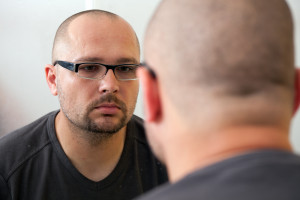 Contributor: Rachael Mattice is the Content Manager for Sovereign Health Group, an addiction, mental health and dual diagnosis treatment provider. Rachael received her bachelor’s degree in journalism and mass communication from Purdue University.
Contributor: Rachael Mattice is the Content Manager for Sovereign Health Group, an addiction, mental health and dual diagnosis treatment provider. Rachael received her bachelor’s degree in journalism and mass communication from Purdue University.
Chronic pain is one of the most difficult medical disorders to live with. It impacts the physical body, social functioning, and can even cause mental illnesses such as depression and anxiety.
In fact, chronic pain can actually change a person’s personality. Chronic pain not only affects the patient, but also affects loved ones.
A spiraling Downfall of Symptoms
Chronic pain patients often have difficulty sleeping, which causes daytime fatigue and leads to stress and depression. People who are unable to enjoy their daily activities because of pain will also show signs of depression.
Physicians also struggle with treating chronic pain patients because it is such a challenging dilemma. The American Academy of Pain Medicine1 states that 100 million Americans and more than 1.5 billion people worldwide suffer from chronic pain.
Depression
 Depression is the most common emotion associated with chronic pain. The American Chiropractic Association2 states that depression is 3 to 4 times more common in people with chronic pain than in the general population. In addition, 30 to 80 percent of people with chronic pain will have some type of depression, according to the ACA.
Depression is the most common emotion associated with chronic pain. The American Chiropractic Association2 states that depression is 3 to 4 times more common in people with chronic pain than in the general population. In addition, 30 to 80 percent of people with chronic pain will have some type of depression, according to the ACA.
Pain provokes an emotional response in people. When people are physically hurting, they become stressed out, anxious, upset: all negative emotions that subside when the pain leaves. Chronic pain, however, doesn’t go away and, as a result, these emotions often remain and lead to depression. Chronic pain and depression go hand in hand.
How Depression and Pain Work in the Brain
The two neurotransmitters that are responsible for depression are serotonin and norepinephrine. These two neurotransmitters have also been implicated in the underlying proven cause of chronic pain. The pathways of serotonin and norepinephrine begin in an area known as the brainstem, which is responsible for the simplest reflexes.
These pathways lead to many brain regions such as the hypothalamus, frontal cortex and the limbic region. The limbic system, in particular the amygdala, is the area of the brain that is responsible for emotions and plays a key role in depression. These pathways also connect the brainstem to the spinal cord where physical pain is suppressed.
In depressed patients, serotonin and norepinephrine, and their respective receptors are altered and reduced, becoming dysfunctional over time, leading to a broken system. When this system is broken, the pain pathways also become altered, causing an increase of physical pain in the body.
Treatments for Depression and Chronic Pain
 Opioids are commonly prescribed painkillers that work on the mu opioid receptors in the brain to release dopamine, a neurotransmitter responsible for euphoria, addiction and pain relief.
Opioids are commonly prescribed painkillers that work on the mu opioid receptors in the brain to release dopamine, a neurotransmitter responsible for euphoria, addiction and pain relief.
Opioids are used to treat chronic pain. However, they do not treat the depression that is associated with chronic pain and, in fact, have a high potential for addiction, which can lead to even more severe depression.
Selective Serotonin Reuptake Inhibitors
Selective serotonin reuptake inhibitors (SSRIs) and tricyclic antidepressants (TCAs), such as amitriptyline, are used to treat chronic pain and depression simultaneously. Both of these medication classes work to produce more serotonin and norepinephrine and, therefore, treat both symptoms of depression and chronic pain.
Physical exercise helps patients with chronic pain as it strengthens muscles and prevents injuries. Physical exercise also helps with depression by releasing the same neurotransmitters that antidepressant medications increase.
Alternative Treatments
Focusing on mental and spiritual health also can help with chronic pain and depression. Chronic pain patients often allow themselves to become disabled and fall into a victim role, which results in low self-esteem and feelings of worthlessness.
 It is important to focus on positive thinking and maintaining a healthy mental and spiritual outlook on life. Relaxation training, hypnosis, biofeedback and guided imagery can help with chronic pain and depression.
It is important to focus on positive thinking and maintaining a healthy mental and spiritual outlook on life. Relaxation training, hypnosis, biofeedback and guided imagery can help with chronic pain and depression.
Cognitive Therapy
Cognitive therapy can help patients recognize destructive emotional and behavioral patterns, and help them modify those behaviors and replace them with more positive ones.
“In one study, at the end of a 10-week cognitive therapy program, 95 percent of patients felt their lives were improved, and 50 percent said they had less pain,” according to Beverly E. Thorn, Ph.D., in her book3 , “Cognitive Therapy for Chronic Pain: A Step-by-Step Guide.”
Treating chronic pain and depression requires multiple types of treatment modalities, so it is important that patients and clinicians both take an active role and work together to manage the pain.
If you or someone you know has chronic pain and is showing signs of depression, the above treatment options can help you find the road to relief.
Community Discussion – Share your thoughts here!
Have you tried exercise and physical therapy to overcome chronic pain, what successes have you had? What advice do you have to share?
About the Author:
Rachael Mattice is the Content Manager for Sovereign Health Group, an addiction, mental health and dual diagnosis treatment provider. Rachael is a creative and versatile journalist and digital marketing specialist with an extensive writing and editing background.
Her portfolio includes numerous quality articles on various topics published in print and digital formats at award-winning publications and websites. To learn more about Sovereign Health Group’s mental health treatment programs and read patient reviews, visit http://www.sovhealth.com/. Follow Sovereign Health Group on Twitter, Facebook, Google+ and LinkedIn.
The opinions and views of our guest contributors are shared to provide a broad perspective of addiction. These are not necessarily the views of Addiction Hope, but an effort to offer discussion of various issues by different concerned individuals.
References:
- The American Academy Of Pain Medicine. (n.d.). Retrieved April 27, 2015, from http://www.painmed.org/patientcenter/facts_on_pain.aspx
- The American Academy Of Pain Medicine. (n.d.). Retrieved April 27, 2015, from http://www.painmed.org/patientcenter/facts_on_pain.aspx
- Cognitive Therapy for Chronic Pain: A Step-by-Step Guide. (n.d.). Retrieved April 27, 2015, from http://www.guilford.com/books/Cognitive-Therapy-for-Chronic-Pain/Beverly-Thorn/9781572309791
Last Updated & Reviewed By: Jacquelyn Ekern, MS, LPC on May 6th, 2015
Published on AddictionHope.com
